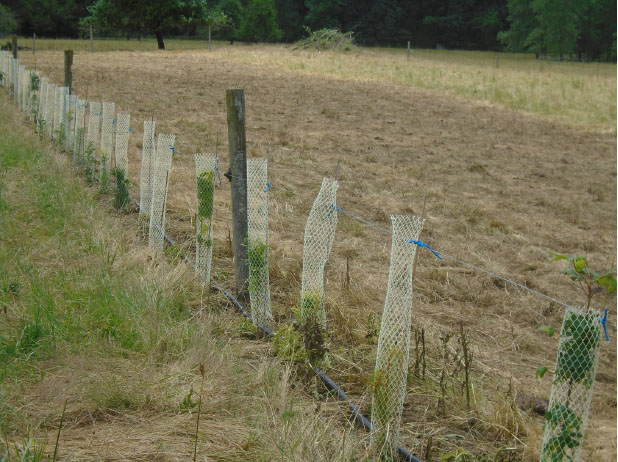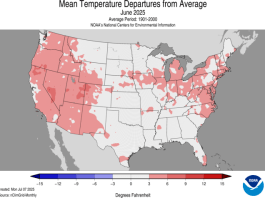In 1839, a bumbling inventor named Charles Goodyear left a gooey mixture of raw rubber and sulfur on the stove while he took a nap. The result was Vulcanized rubber, a material that revolutionized manufacturing around the world. Was he a genius or a nincompoop? Who knows?
 I had my own brush with unintended discoveries last week while moving cattle into the paddocks near the Hedgerow Project. You can learn more about the project this week in Looking Back, Looking Forward including my planting technique: I plant the trees in plastic tubes, support them with a single bamboo stake, and tie them directly to a single hot wire with pretty blue twine.
I had my own brush with unintended discoveries last week while moving cattle into the paddocks near the Hedgerow Project. You can learn more about the project this week in Looking Back, Looking Forward including my planting technique: I plant the trees in plastic tubes, support them with a single bamboo stake, and tie them directly to a single hot wire with pretty blue twine.
The photos below show the hedgerows I’m planting surrounding a pasture called the Plum Thicket. I was placing 150 seven-weight steers there for the night. My visual appraisal told me that the paddock didn’t have quite enough forage for the night, so I set up a poly fence to section off a strip of the adjoining paddock, and let the steers in.

As fate would have it, I neglected to actually open the gate leading from the strip into the Plum Thicket pasture. This resulted in what I now term Unintended Mob Grazing (UMG), exposing the strip of forage to 12 hours of herd impact at around 100,000 pounds per acre. The next morning I found that the strip had been devastated, to say the least.


I was horrified at first, but soon decided to look at it as a sort of experiment. I will now get to see the results of UMG on next year’s sward. Great! But I quickly noticed something else:
Even under massive pressure and starvation diet,
the cattle did not molest the baby trees.
Not one tube was destroyed, not one seedling killed. I take this as fairly convincing proof that our hedgerow design will withstand normal grazing pressure.

All of this makes me very confident going forward. With this evidence in hand, I’m thinking of seriously ramping up our hedgerow project next year. My new goal is to plant new hedgerows on every north/south fence line on the ranch in 2023. If mother nature obliges, we will soon be the business of providing shade for the cattle and corridors for the wildlife.
Incompetence? Luck? Divine intervention? Fate? I’m not sure, but the outcome is pretty encouraging. I’m hoping to be looking at healthy hedgerows in just a few years.
May all your mistakes turn into great discoveries too!
John
Note from Kathy: John has been writing some great short stories about folks struggling to survive and thrive in rural America. (I’m his editor so I may be biased.) We hope to have the first set out by fall, with more to follow. I’ll drop you a note so that you can come by On Pasture and check them out. 🙂





I hope you’ll follow up and keep us posted on how it looks in a year or so. What did you plant in the hedgerows? What purpose will the hedgerows serve? Will they be impenetrable?
Hi Elizabeth.
All of our commercial and riparian tree planting has been completed with native species. I like this approach, as it would seem to support local wildlife. I try to select species on a micro-site basis, putting individual trees where I think they will do well.
As to your other questions, I am not building fences, I am growing trees that will produce shade and act as wildlife corridors. The single electrified wire that is integrated into the design is a permanent and very effective fence.
Best wishes,
John
Comments are closed.